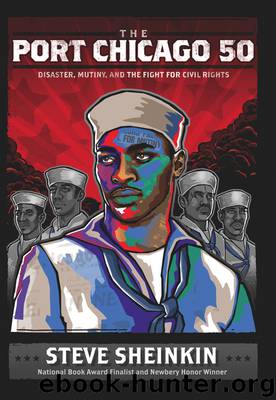The Port Chicago 50 by Steve Sheinkin

Author:Steve Sheinkin
Language: eng
Format: epub
Publisher: Roaring Brook Press
PROSECUTION
THE MUTINY TRIAL on Treasure Island was a minor story in most newspapers, overshadowed by bigger articles on American forces battling in Western Europe and the Pacific. But to African Americans across the country, this was an important story that would have to be watched closely.
“We concede the fact that a superior officer’s command is to be obeyed, but we know that prejudice exists in the Navy,” Irma Lewis, an Oakland woman, told a newspaper reporter. “We mothers want to know why these loading crews are all Negroes.”
Joseph James, president of the San Francisco branch of the NAACP, was also following the story. “The Negro people are well aware of the pattern of discrimination practiced by the Navy,” James told papers, “and they are very much concerned about this trial.” James alerted the New York City headquarters, letting lead lawyer Thurgood Marshall know that this was a case worth watching.
The secretary of the Navy, James Forrestal, was keeping an eye on the trial from his office in Washington, D.C. Forrestal took a particular interest in the case, because he’d been thinking about the Navy’s segregation policy. From his point of view, segregation was causing unnecessary problems. Treating black sailors like second-class citizens damaged the morale of the men, leading to headaches like the ongoing trial on Treasure Island. Also, it was wasteful to build separate barracks and classrooms, and it was wasteful to restrict black sailors to shore duty when men were needed on ships.
Forrestal was well aware of the basic assumption used to justify keeping the races separated—that packed together aboard ships black and white sailors simply wouldn’t get along. He suspected it was nonsense.
With the backing of President Roosevelt, Forrestal approached Admiral Ernest King, Chief of Naval Operations.
“Admiral, I’d like to make a change in our racial policies,” Forrestal began. “The President wants it, and I want it. How do you feel?”
“I don’t know if we can do it,” King said, “but if you want to try, I’ll back you up every step of the way.”
That summer, Forrestal and King began an experiment. The Navy assigned black sailors to serve alongside mostly white crews on twenty-five large, noncombat ships. King told the ships’ commanding officers to report back on the results.
* * *
In the crowded courtroom on Treasure Island, James Coakley continued his prosecution.
After getting the testimony of the white officers, Coakley turned to a second set of witnesses—black sailors who had refused to load ammunition on August 9, but who had agreed to go back to work after Admiral Wright’s threatening talk on August 11.
These witnesses were key for Coakley. It was his intention to show that the fifty accused mutineers had conspired together, enacting a secret plot they’d agreed upon ahead of time. The accused men denied that any such plot existed, but Coakley was hoping to get a different answer from some of the men who’d gone back to work.
Calling a sailor named Edward Johnson to the stand, Coakley asked him to describe any talk he’d heard in the barracks on the night of August 8.
Download
This site does not store any files on its server. We only index and link to content provided by other sites. Please contact the content providers to delete copyright contents if any and email us, we'll remove relevant links or contents immediately.
The Kite Runner by Khaled Hosseini(4435)
Bloody Times by James L. Swanson(3980)
The Mayflower and the Pilgrims' New World by Nathaniel Philbrick(3914)
Pocahontas by Joseph Bruchac(3724)
Flesh and Blood So Cheap by Albert Marrin(3395)
An American Plague by Jim Murphy(3367)
For the Love of Europe by Rick Steves(3202)
The 101 Dalmatians by Dodie Smith(2936)
Hello, America by Livia Bitton-Jackson(2723)
Finding Gobi by Dion Leonard(2260)
Harry Potter and the Half-Blood Prince (hp-6) by J. K. Rowling(2140)
The Impossible Rescue by Martin W. Sandler(1971)
See You in the Cosmos by Jack Cheng(1822)
I Will Always Write Back by Martin Ganda(1765)
Bloody Times: The Funeral of Abraham Lincoln and the Manhunt for Jefferson Davis by James L. Swanson(1723)
The Queen of Attolia by Megan Whalen Turner(1697)
When Dimple Met Rishi by Sandhya Menon(1679)
The Crossover by Kwame Alexander(1622)
Hoodoo by Ronald L. Smith(1575)
